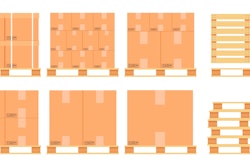
A load diagram is a depiction of how a given shipment of pallet loads is to be positioned inside a trailer. The diagram is a pre-loading instruction, not a post-loading documentation. Load diagrams might not be necessary for repetitive shipments of the same composition, given a prior determination of the load pattern. When shipments vary by composition, however, load diagrams can provide multiple benefits, starting with the loading process and continuing throughout the supply chain. There are factors to be considered prior to the production of a load diagram.
Pallet loads arrive at the outgoing shipping dock via different routes, for example, from warehouse storage, directly from end-of-the-line operations, or by cross-docking. The best practice is to have the entire order collected and staged before loading commences. A load diagram is the preferred alternative to having to rely on the discretion of the loader (a forklift driver, for example).
Since a trailer is a three-dimensional enclosure, the challenge is to optimize the use of its cube. A twin challenge is compliance with state and federal regulations that set maximum combined weights (tractor, trailer, load). Loads, therefore, at most, can either “cube-out” or “weigh-out.” For any truckload (TL), the questions are how many pallet loads can there be, and how should they be positioned?
Assume a 53-ft trailer and 48-in x 40-in pallets. If the pallets are straight-loaded (length of pallet running parallel to length of trailer), 13 pallets can be aligned in a row, along the trailer’s length. Trailer width allows two such rows, for a total of 26. If the pallets are turn-loaded (length of pallet running parallel to width of trailer), 15 pallets can be aligned in a row, along the trailer’s length. Trailer width allows two such rows, for a total of 30. When the additional four pallets can be had without exceeding weight limits, fewer trailers will be needed, yielding savings in transportation costs, along with sustainability/environmental benefits. On the other hand, straight loading is faster, providing higher shipping dock productivity and efficiency.
Pinwheeling is a third way to load a trailer. There, too, pallets are arranged two-across. However, one is straight-loaded, the other turn-loaded. The pairings alternate positions along the trailer’s length, yielding a pattern that accounts for the name. It is a more complicated loading, at times used when the trailer’s width is too narrow for turn-loading (not the case with a 53-ft trailer and 48-in. x 40-in. pallets).
How much a pallet load should weigh can be estimated by dividing the maximum cargo weight allowed by regulations by the number of pallet loads. If the weight limit that the trailer can carry is 42,000 lb or thereabout, for example, dividing by 26 and by 30 yields a per-pallet-load weight of 1,615 lb and 1,400 lb, respectively. The optimal utilization of a trailer, therefore, requires the optimal number of pallet loads, each at the optimal per-pallet load weight.
But reality has a habit of imposing itself against theory. An example is products that are comparatively lightweight. Pallet loads can be stacked to better utilize cube and weight limits. It’s possible that the aforementioned per-pallet load weights will result in a pallet load height that’s too great for stacking. The needed tradeoff is a shorter pallet-load height and a lighter per-pallet-load weight, in exchange for the ability to stack the pallet loads.
Another reality is that a trailer needs to have its load’s weight distributed evenly, with special attention afforded to the weight placed over the trailer’s axles. While in transit, trailers exit the highway, pulling into weigh stations to be checked for compliance with regulatory weight limits. Non-compliance must be corrected on the spot, before the trailer can leave the station. A variety of consequences can result. Among the worst is when the driver has to break the seal on the trailer’s doors to correct the weight distribution, and thereafter, the consignee rejects the shipment because the seal was broken.
Yet another reality is that loads must be blocked and braced so that they remain immobile during transit. How the pallet loads are positioned determines the size and location of the voids that have to be filled or otherwise accommodated. Take the example of a straight-loaded trailer, with each row of pallets placed against the adjacent wall, leaving a void down the center. Airbags and/or boards nailed into the trailer’s floor are popular methods. For back-of-trailer restraint, load bars are popular. Loads that move and shift within a trailer are not just a hazard for cargo damage. They also pose a safety hazard by interfering with the stability of and the steering of the trailer.
A final reality worth mentioning is that the loading process should take into consideration the unloading process. The latter simply is the reverse of the former. As a generality, therefore, methods that are the most productive and efficient for loading make for productivity and efficiency in unloading.
Sterling Anthony, CPP, consults in packaging, marketing, logistics, and human-factors. A former faculty member at the Michigan State University School of Packaging, his contact info is:100 Renaissance Center, Box-176, Detroit, MI 48243; 313/531-1875; [email protected].























